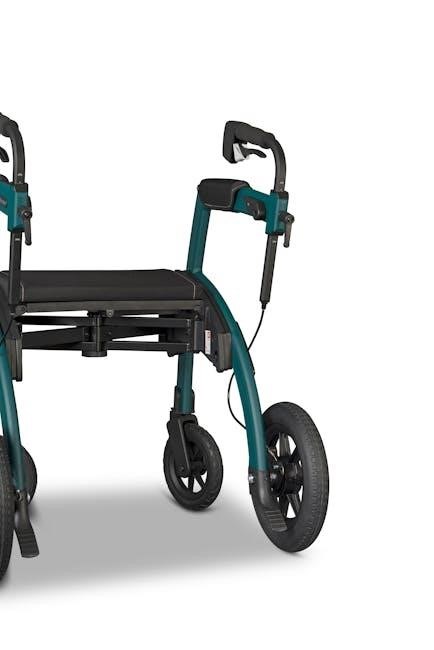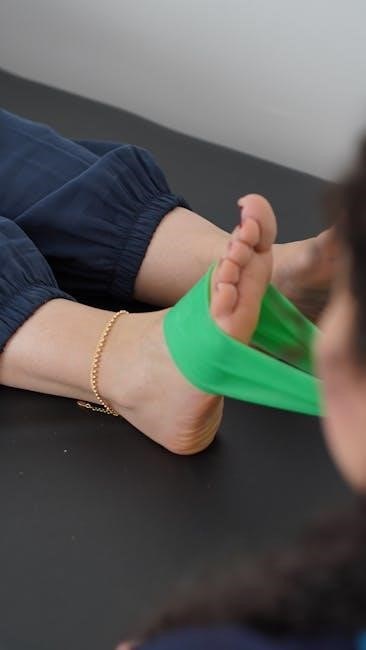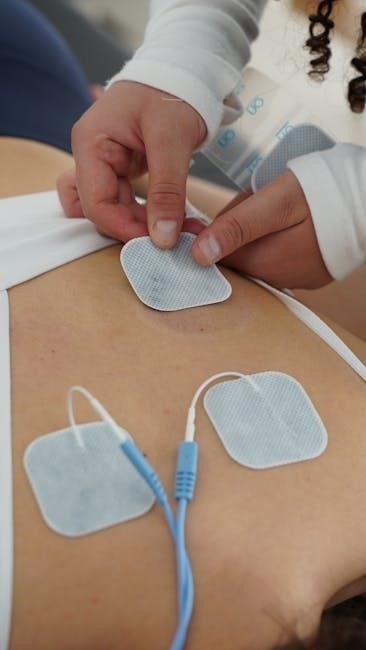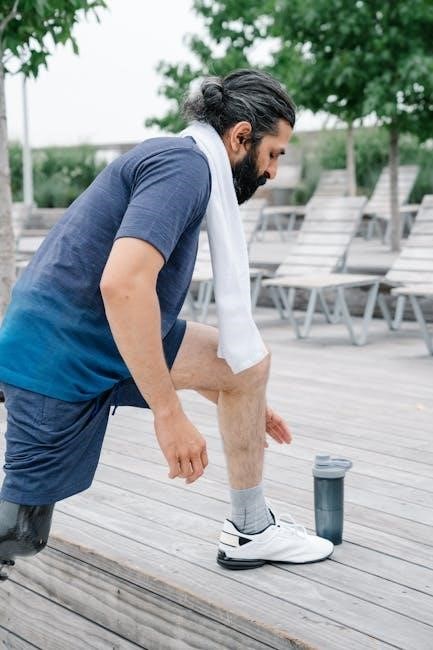PCL rehabilitation involves a structured approach with multiple phases, emphasizing the importance of proper healing and functional restoration. Tailored to each patient’s needs, evidence-based protocols guide the recovery process, ensuring optimal outcomes through time and criterion-based progression.
1.1 Understanding the Posterior Cruciate Ligament (PCL)
The Posterior Cruciate Ligament (PCL) is a critical structure in the knee, providing stability by preventing excessive posterior tibial translation and internal rotation, especially at 90 degrees of flexion. Comprising two bundles—the anterolateral (ALB) and posteromedial (PLB)—the PCL plays a vital role in maintaining knee joint integrity. Unlike the ACL, PCL injuries often occur in isolation but can significantly impact knee function, leading to instability and functional limitations. Understanding the PCL’s anatomy and biomechanical function is essential for developing effective rehabilitation strategies, as improper healing or reconstruction can result in chronic instability and reduced athletic performance. This knowledge forms the foundation for designing targeted exercises and protocols.
1.2 Importance of Rehabilitation After PCL Injury or Surgery
Rehabilitation after a PCL injury or surgery is crucial for restoring knee function, strength, and stability. Proper rehabilitation prevents chronic instability, reduces the risk of further damage, and ensures a safer return to sports or daily activities. Early immobilization and controlled mobilization protect the healing ligament, while progressive exercises target muscle strength and joint mobility. Without adequate rehabilitation, patients may face long-term limitations in movement and increased susceptibility to degenerative changes. A well-structured rehabilitation program, tailored to individual progress, is essential for achieving pre-injury activity levels and minimizing complications. This phase lays the groundwork for successful recovery, emphasizing the need for adherence to prescribed protocols and exercises.

Phases of PCL Rehabilitation
PCL rehabilitation follows a structured, multi-phase approach, emphasizing time and criterion-based progression. It includes immobilization, gradual weight-bearing, strengthening, and functional exercises to restore knee stability and function effectively.
2.1 Phase I (0-2 Weeks): Immobilization and Pain Management
Phase I focuses on immobilization and pain management immediately post-injury or surgery. A brace is typically used to lock the knee in full extension, protecting the PCL. Weight-bearing is gradually introduced as tolerated, often with crutches to minimize stress on the knee. Pain management involves ice therapy and anti-inflammatory medications. Simple exercises like isometric quad sets, ankle pumps, and straight leg raises are initiated to maintain muscle activity without risking PCL tension. The goal is to reduce swelling, control pain, and prepare the knee for progressive movements in later phases. Patient adherence to immobilization is crucial during this period to ensure proper healing.
2.2 Phase II (2-6 Weeks): Progression to Weight Bearing and Range of Motion
During Phase II, the focus shifts to gradual weight-bearing and improving knee range of motion. The brace is adjusted to allow controlled flexion, typically up to 90 degrees, while avoiding excessive stress on the PCL. Weight-bearing progresses from partial to full, with crutches used initially for support. Gentle exercises such as straight leg raises, prone hip abduction, and calf stretches are introduced to enhance mobility and strength. Isometric exercises continue to maintain quadriceps and hamstring function. Pain and swelling are managed with ice and anti-inflammatory medications. The goal is to restore functional movement while protecting the PCL, ensuring a stable foundation for more advanced exercises in later phases.
2.3 Phase III (6-12 Weeks): Strengthening and Functional Exercises
Phase III emphasizes strengthening and functional exercises to restore knee stability and prepare for return to activity. Advanced exercises like single-leg squats, step-ups, and balance drills are introduced to enhance neuromuscular control. Strengthening focuses on the quadriceps, hamstrings, and hip muscles to improve joint stability. Functional drills mimic daily and athletic movements, ensuring the knee can handle dynamic loads. Progression to low-impact activities such as swimming or cycling is allowed, while avoiding high-impact or contact sports. The goal is to achieve full strength and functionality, ensuring the knee can withstand normal stresses and strains, setting the stage for a safe return to sports or active lifestyles in later phases.

Key PCL Rehabilitation Exercises
Key PCL rehabilitation exercises include isometric quad sets, straight leg raises, hamstring stretches, and prone hip exercises. These exercises improve strength, flexibility, and knee stability progressively.
3.1 Isometric Quad Sets and Straight Leg Raises
Isometric quad sets and straight leg raises are essential in early PCL rehabilitation. These exercises strengthen the quadriceps without stressing the ligament. Quad sets involve contracting the thigh muscles with the knee straight, holding for 5-10 seconds. Straight leg raises are performed by lifting the leg while keeping the knee fully extended, enhancing strength and control. Both exercises improve knee stability and prepare the joint for more advanced movements. They are typically done 3-4 sets of 10-15 repetitions daily, ensuring proper form to avoid unnecessary strain on the PCL during the healing process.
3.2 Hamstring and Calf Stretching Exercises
Hamstring and calf stretching exercises are crucial for maintaining flexibility and preventing tightness during PCL rehabilitation. Standing hamstring stretches involve leaning forward at the hips, keeping the knees straight, and holding for 20-30 seconds. Seated hamstring stretches target the posterior chain, with the legs extended and feet flexed. Calf stretches, such as the wall push-up or step stretches, focus on the gastrocnemius and Achilles tendon. These exercises are performed 2-3 times daily, ensuring muscles remain supple and balanced. Proper stretching helps reduce tension on the PCL, promoting a full range of motion and supporting the overall recovery process without compromising ligament integrity.
3.3 Prone Hip Abduction and Adduction
Prone hip abduction and adduction exercises strengthen the gluteal muscles and improve hip stability, which is essential for knee function during PCL rehabilitation. The patient lies prone with legs straight, then lifts one leg outward (abduction) and returns it to the starting position before performing an inward movement (adduction). These exercises are performed without knee bending to avoid stressing the PCL. Typically, 3 sets of 10-15 repetitions are recommended. Proper form and controlled movements are emphasized to prevent compensatory patterns. Prone hip exercises help restore muscle balance and promote functional strength, making them a key component of the strengthening phase in PCL rehabilitation protocols.

Return to Sports and Activity
Return to sports requires achieving full strength, stability, and functional movement. Criteria include passing functional tests, regaining pre-injury performance levels, and medical clearance to ensure safety and readiness.
4.1 Criteria for Safe Return to Athletic Activities
The safe return to athletic activities after PCL rehabilitation requires achieving full knee strength, normal range of motion, and passing functional tests. Patients must demonstrate pain-free movement, stable joints, and pre-injury performance levels. Medical clearance is essential, ensuring no residual instability or swelling. Psychological readiness and confidence in the knee’s functionality are also critical. A gradual progression to sports-specific drills is recommended to avoid re-injury. Typically, return to contact or collision sports is delayed until 9-12 months post-operation, allowing ample time for tissue healing and strength restoration. Meeting these criteria ensures a safe and effective transition back to athletic activities.

4.2 Gradual Progression to Contact or Collision Sports
Progression to contact or collision sports after PCL rehabilitation is gradual and carefully monitored. Typically, patients are cleared for return around 9-12 months post-operation, following demonstrated strength, stability, and functional readiness. The process begins with controlled, non-contact drills to assess reaction time and agility. Once these are mastered, sport-specific skills are introduced, focusing on pivoting, cutting, and deceleration. Psychological readiness and confidence in the knee’s stability are critical. Final clearance involves passing functional tests and demonstrating pre-injury performance levels. This approach minimizes re-injury risk while ensuring a smooth transition to high-demand activities. The timeline may vary based on individual healing and surgeon recommendations.
PCL rehabilitation is a structured process emphasizing proper healing, functional restoration, and safe return to activities, with outcomes focused on restored strength and improved knee function.
5.1 Summary of Rehabilitation Goals and Outcomes
The primary goal of PCL rehabilitation is to restore knee function, strength, and stability while minimizing the risk of further injury. Through structured exercises and progressive phases, patients aim to achieve full range of motion, reduce pain, and improve functional abilities. Successful rehabilitation typically results in enhanced knee stability, strength, and the ability to return to pre-injury activities. Outcomes vary based on adherence to the protocol and individual healing rates, but most patients experience significant improvement in knee function within 9-12 months post-injury or surgery. The ultimate objective is to enable patients to resume daily activities and sports safely, ensuring long-term joint health and functionality.
